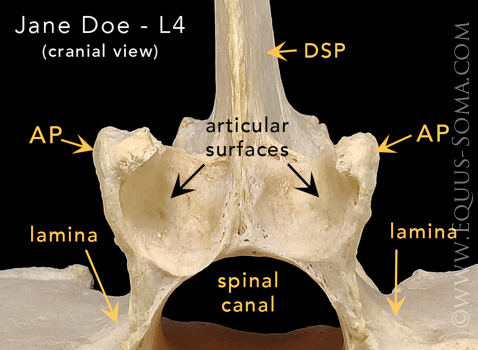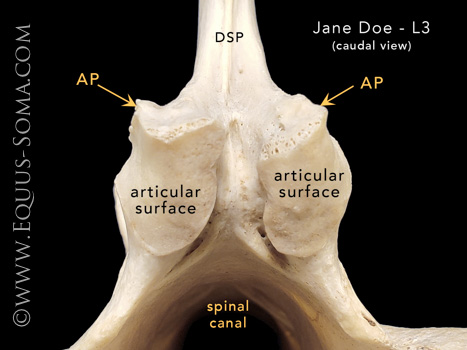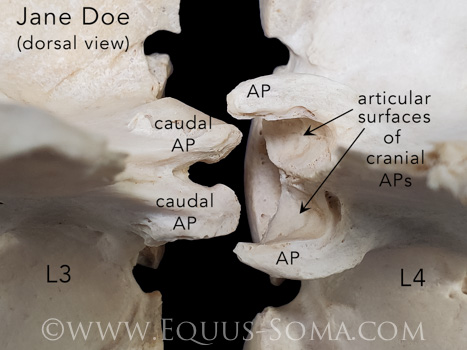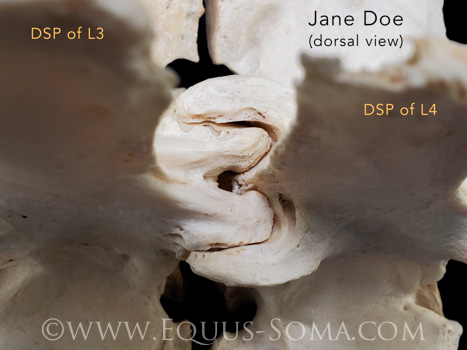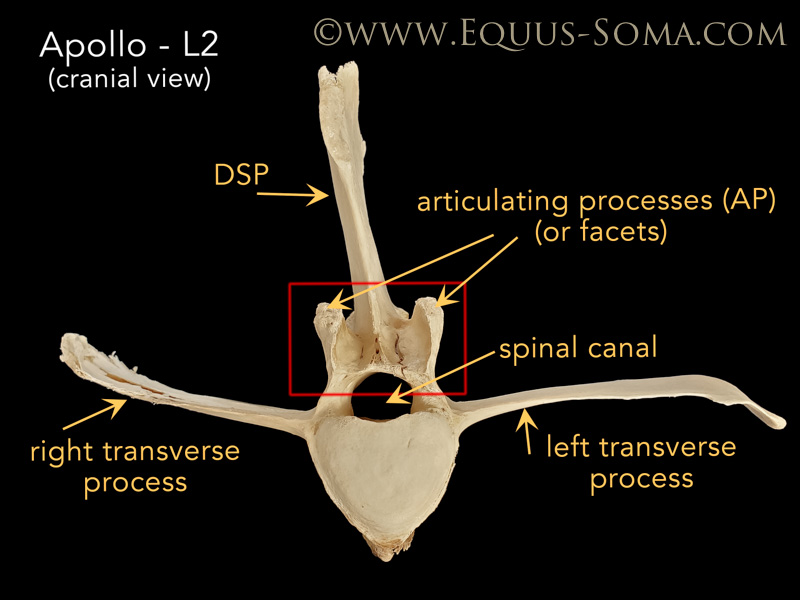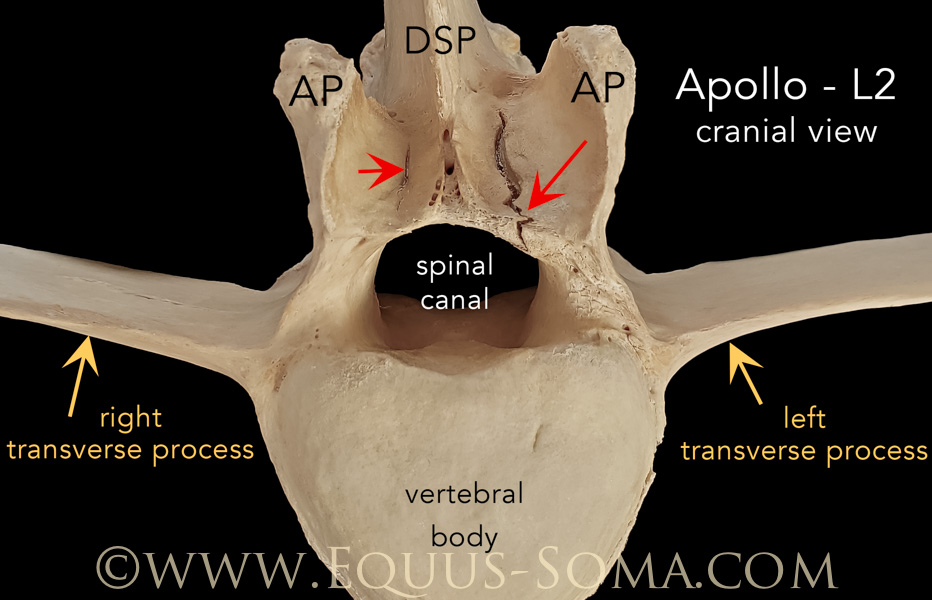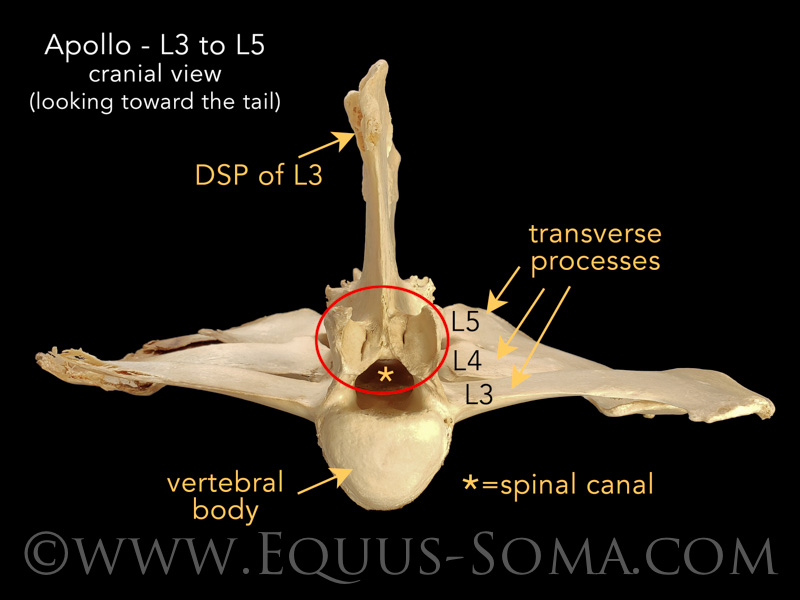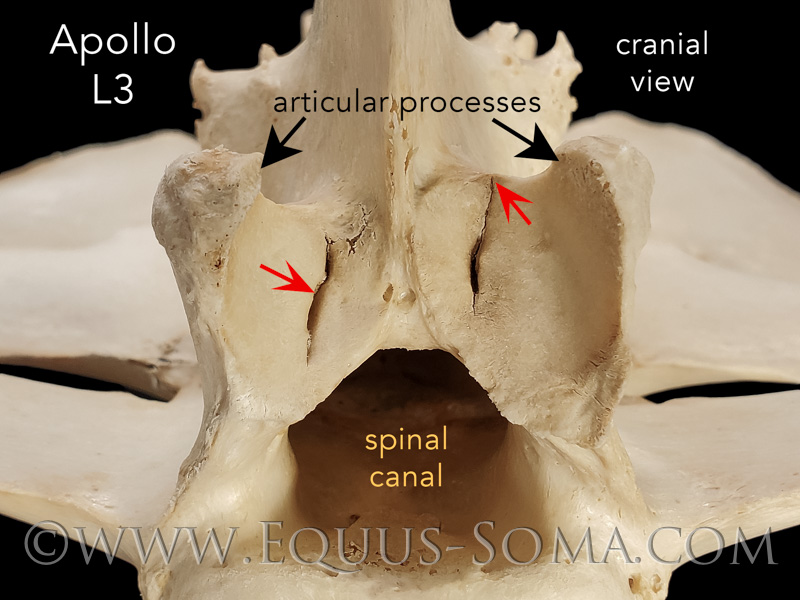Aiken, SC
info@equus-soma.com
Equus-Soma
Equine Osteology & Anatomy Learning Center
Waldoboro, ME
207-542-6132
Apollo's Story - What Lies Beneath - Part Two
**Please be sure to read Part One of Apollo's Story to better appreciate what is described here in Part Two.***** To better understand the anatomy discussed in Apollo's Story, I strongly recommend everyone read this publication.***
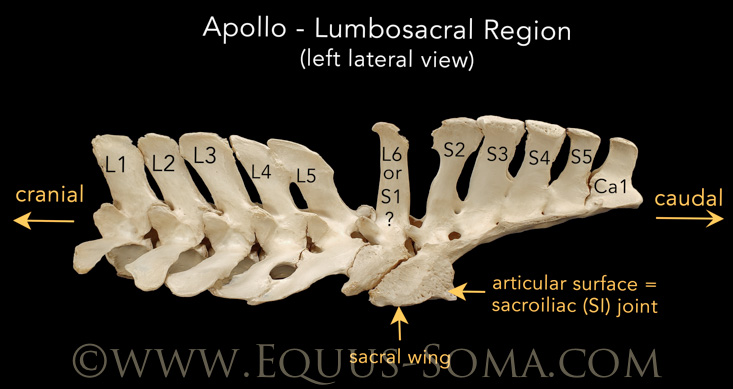
The photo to the right is of Apollo's lumbosacral region as viewed from the left side. (Click on photo to enlarge.)
Notice the relative angles of the dorsal spinous processes. Those of the lumbar vertebrae (L1-L5) are oriented craniad (toward the head) and those of the sacrum (S2-S5) are oriented caudad (toward the tail). Whereas, the angle of the spine of the "sacralized" L6 vertebra is relatively more neutral and there is a wider interspinous space on either side.This is referred to as "spinal process divergence" and it generally occurs between L6 (or the last lumbar) and S1, i.e., at the lumbosacral joint, although divergence has been reported to take place between L5 and L6 (see Apollo refs. #5 & 14).
This is significant because the (typical) lumbosacral junction (L6-S1) exhibits the largest range of dorsoventral flexion and extension in the thoracolumbar spinal column and this range of motion is dependent, in part, upon the amount of open space (divergence) between the spinous processes. For those interested in more detail on this subject, you will want to read this paper by Jean-Marie Denoix.
In 2006. Stubbs et al., (Apollo ref. #14) published a detailed study on variations in spinal anatomy and associated (dorsally-located) epaxial muscles. They described differences in the thoracolumbar (TL) and lumbosacral (LS) vertebral "formula" including location and degrees of spinous process divergence in the LS region.
The authors point out that "divergence of the spinous processes between L5-S1 may impact spinal mobility at the point of greatest dorsoventral motion and, therefore, affect performance and development of pathology in the LS region."
With respect to Apollo ... due to the sacralization of his's L6, the articulation in his lumbosacral region capable of the most dorsoventral flexion/extension had to have been between L5 and L6 and not between L6 and S1, the latter of which is considered more "typical".
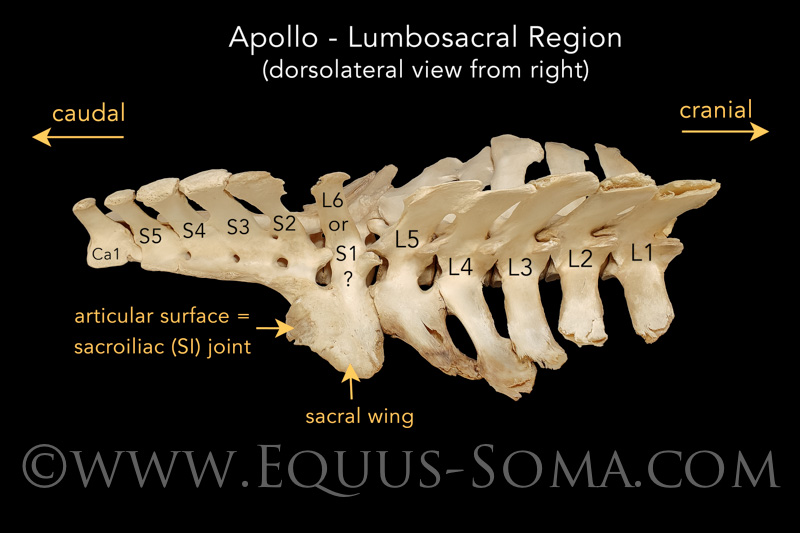
The photo to the left is a dorsolateral view looking down from the right side to better show the wing-like transverse processes of the lumbar vertebrae (L1 through L5), as well as, the fusion of L6 right transverse process with the wing of S1 (= sacralization of L6).
This view also illustrates that the dorsal spinous processes of L5, L4 & L3 are not linear relative to each other, due to overlapping, impingement, and fusion (at L4 & L5). (Click on photo to enlarge.)
(NOTE: the frayed tips of the transverse processes as well as the open ends at the summits of L1 & L2 spines are not pathological, but rather a consequence of the soaking process needed to clean the bones.)
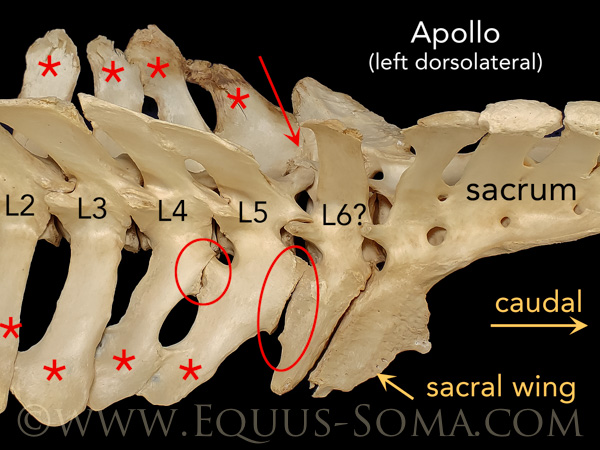
Taking a closer look ....
The red asterisks mark the transverse processes of the lumbar vertebrae. The tips of L3 and L4 overlap and those of L4 and L5 are fused but this is not uncommon. It is believed to be the skeleton's way of adding more support to the area.
The red circles and arrow mark "intertransverse joints" that are normally present between the transverse processes of the last 2 or 3 lumbar vertebrae and at the lumbosacral junction (see Apollo ref. #13 & 20).
It is not unusual for the intertransverse joints between the last 2 lumbar vertebrae to fuse as a mechanism for increasing stabilization in that area. They were just beginning to fuse in Apollo (red arrows).
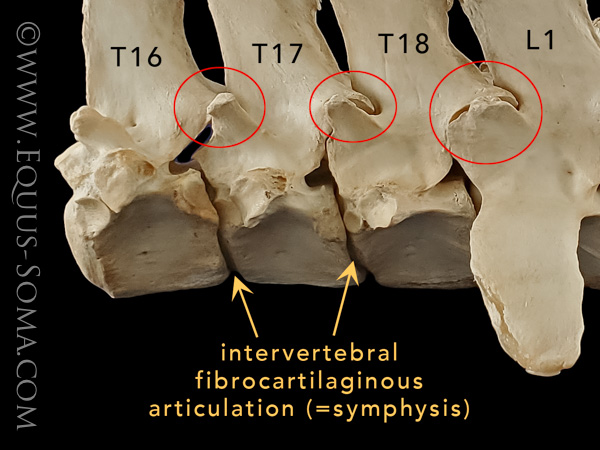
Vertebral Articulations (Joints)
There are two types of articulations in the equine vertebral column, fibrocartilaginous and synovial.
The bodies of adjacent vertebrae are connected by fibrocartilaginous disks. In the photo at right, the yellow arrows point to the intervertebral spaces where fibrocartilaginous disks would have been between adjacent vertebral bodies.
Intertransverse articulations (described above) between the transverse process of the last 2 or 3 lumbar vertebrae and the lumbosacral junction, are synovial joints.
In addition, each vertebra has a pair of cranial and a pair of caudal articular processes (AP) located dorsolaterally above the vertebral arch (spinal canal). APs are also referred to as "facets".
For illustrative purposes, the images below provide various views of the articular processes (AP) between the 3rd & 4th lumbar vertebrae from another skeleton in the Learning Center collection. The size, shape and orientation of the APs are different through the spinal regions and this plays a role in the biomechanics of the whole axial skeleton (see Apollo ref. #16).
These top 2 photos compare the morphology of the cranial APs with that of the corresponding caudal APs and their relative positions between the dorsal spinous processes (DSP) and the vertebral bodies. Notice the articular surfaces of the cranial APs (left photo) are concave and those of the caudal APs (right photo) are convex.
The area of contact of the articular surfaces is called the "synovial intervertebral articulation (SIA)" or "facet joint" (see Apollo ref.#18). The two images below are dorsal views of the same vertebrae as above and illustrate the "lock and key" morphology of the SIA of the lumbar vertebrae. Interlocking of the SIAs in the lumbar region works to stabilize this area.
The articular surfaces should be smooth (as seen above) but in many cases have divots or clefts (see Apollo ref. #6). In fact, osseous lesions have been reported throughout the equine spinal column and can range from mild to severe (see Apollo ref. #15).
But wait .... there's MORE! - STRESS FRACTURES
The photos below are cranial views of Apollo's L2 and L3 vertebrae (compare to those of "Jane Doe" in above photos), with particular attention drawn to the articular surfaces of the cranial APs. We found the presence of what appear to be "stress fractures" as described by Apollo refs. #6, 15 & 16.
The area within the red box in the left photo is enlarged in the right photo. Notice the "cracks" present in the articular surface of both APs. The one on the right articular surface (left in the photo, short red arrow) is small and probably considered a "cleft" (Apollo ref. #6). The "crack" on the left articular surface (longer red arrow) however, extends into the border with the spinal canal. This is considered to be a stress fracture.
Same situation is seen in the cranial APs of Apollo's L3 vertebra (below photos). In this case, the "cracks" are larger on both articular surfaces and the one on the right (left in the photo) extends into the dorsal lamina at the base of the DSP (see Apollo ref. #6 for an extensive discussion on stress fractures in TB racehorses).
PHOTO CREDITS: The majority of images used on this website are property of Equus-Soma (Pamela Blades Eckelbarger). Images of me taken at Presentations are provided courtesy of Helen Peppe and other attending participants (thank you!!). Images on the About page of myself competing with Irish are courtesy of Flatlandsfoto. Images of skeletons in the banners are from Muybridge 1881.
November to July
1165 Shaws Fork Rd.
Aiken, SC 29805Equus-Soma
Equine Osteology & Anatomy Learning Center
Pamela Blades Eckelbarger M.S. Zoology
eqsoma71@gmail.com
(207) 542-61322025 ©ALL RIGHTS RESERVED
July through October
190 Horscents Ln.
Waldoboro, ME 04572
